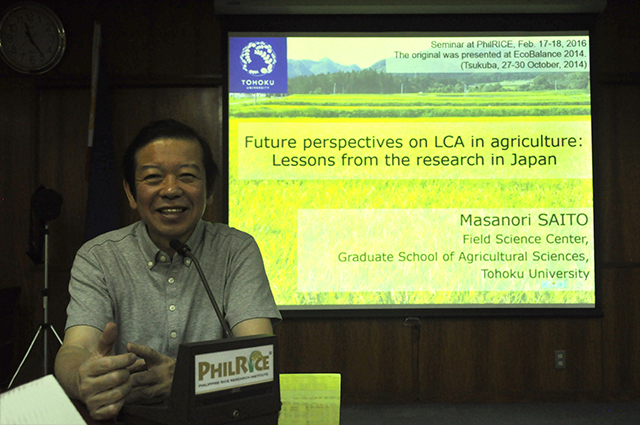 A Japanese Professor from Tohoku University recommended the Life Cycle Assessment (LCA) tool to rice researchers in helping farmers cope with climate change.
A Japanese Professor from Tohoku University recommended the Life Cycle Assessment (LCA) tool to rice researchers in helping farmers cope with climate change.
LCA, according to Professor Masanori Sato, is a technique that enables industries to identify the resource flows (water and energy inputs), and environmental impacts (GHG emissions) associated with the provision of products and services.
Researchers and decision makers will find LCA useful in giving concrete recommendations to farmers on what alternative technologies, products, processes, or services that they can use in climate change mitigation.
“Nowadays, industries like farming use resources such as water and energy as inputs. The common misconception is that we tend to focus on the first and last parts of the whole farming system, without knowing that a large chunk of carbon dioxide and greenhouse gas (GHG) emissions occur in the production stage. Using LCA as a tool, we can evaluate the environmental effects of a product throughout its life cycle, from cradle to grave,” Saito said during a lecture at the Philippine Rice Research Institute (PhilRice), 17 Feb.
 Aside from LCA’s environmental benefits, Saito also mentioned how it contributed to the improvement of rice production in Japan. His team discovered that most carbon dioxide and GHG emissions occur in the middle of the production and drying stage. Their rice industry responded by changing from a conventional tillage to a reduced tillage system where CO2 and GHG emissions are relatively low.
Aside from LCA’s environmental benefits, Saito also mentioned how it contributed to the improvement of rice production in Japan. His team discovered that most carbon dioxide and GHG emissions occur in the middle of the production and drying stage. Their rice industry responded by changing from a conventional tillage to a reduced tillage system where CO2 and GHG emissions are relatively low.
“Using LCA is now a necessity as it helps businesses and industries better understand the environmental impacts of their practices. It aids in making informed decisions in process improvement as they reduce production costs, while also mitigating adverse impacts to the environment,” Saito added.
LCA can be a great tool for decision makers to make sound recommendations for farmers to adapt or follow, and to become resourceful and strategic in finding less GHG-emitting processes to substitute their current conventional practices.
Meanwhile, Engr. Elmer Bautista of PhilRice, also conducted a study on LCA titled, ‘Evaluation of the energy input-output and greenhouse gas emissions of rice production systems in the Philippines and possible mitigation technologies.’
“When you do LCA, you will know each step in the rice production process. You can identify which step produces the most emissions. From there, we plan our actions,” Bautista said.
He also mentioned that LCA is not widely used in the country because people are not informed about it.
Saito and Bautista encouraged more Filipino researchers to use LCA like what Japan and Australia did to reduce the harmful gas emissions during production.
“Climate change is now affecting all industries, not only in the agricultural sector. This is a call for everyone to be responsible in their practices. Since climate change is inevitable, the most we can do is not to contribute to its effects,” Saito concluded.




